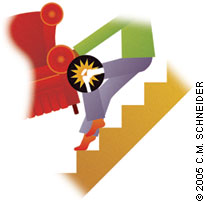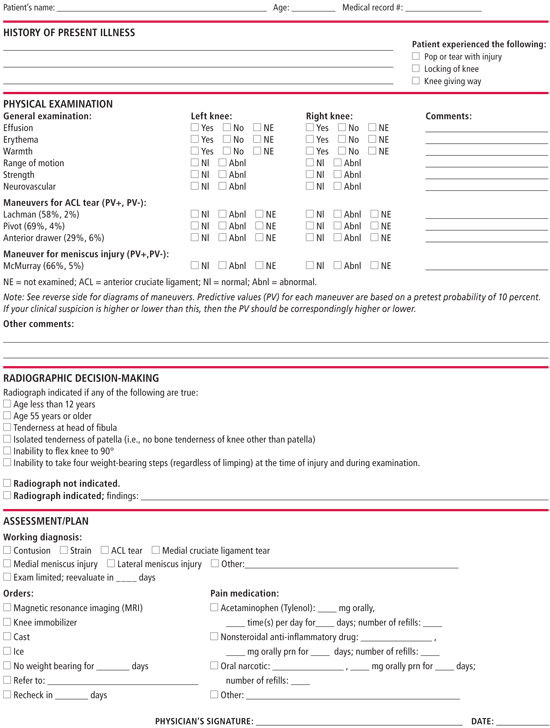
The most widely used tests may not be the most effective.
Fam Pract Manag. 2005;12(3):67-70

A 38-year-old patient experiences sudden, severe pain in his left knee as he pivots on that leg to lift a couch up some stairs. He is able to ambulate initially but later develops locking relieved by shaking his leg gently. On examination, he has a small effusion, no erythema, nearly normal range of motion and slight joint line tenderness medially. There is no tenderness of the patella or head of the fibula. How would you evaluate this patient?
Treatment options
Physical examination maneuvers such as the Lachman test, the anterior drawer test, the pivot test and the McMurray test have traditionally been recommended for patients with acute or subacute knee injury. A recent systematic review looked at which of these maneuvers are most effective.1 The systematic review identified 35 studies involving the maneuvers that used arthroscopic results as the reference standard. Although most of the studies contained design flaws (e.g., the arthroscopist was not blinded to the physical examination findings), they still provide important guidance regarding the relative accuracy of the most widely used maneuvers.
Findings from the systematic review are summarized in "Comparing maneuvers." They suggest that a positive Lachman test or pivot test is strong evidence in favor of an anterior cruciate ligament (ACL) tear, while a negative Lachman test is fairly good evidence against that injury. Although widely used, the anterior drawer is actually the least accurate maneuver for diagnosing this injury. Regarding meniscal injury, joint line tenderness is not very helpful at ruling in or ruling out the injury, while the McMurray test is most helpful when positive.
Radiography is also widely used but in many cases is unhelpful. Several clinical decision rules have been developed to assist physicians in identifying patients who are at very low risk of bony injury and do not require radiograph. The Pittsburgh Knee Rule recommends a radiograph for anyone with a fall or blunt-trauma mechanism, anyone younger than 12 years or older than 50 years, and anyone unable to take four weight-bearing steps in the emergency department (or, presumably, the primary care office).2 In a prospective validation by the developers of the rule using a convenience sample of 934 patients age 6 years to 96 years with acute knee injury, the rule was 99 percent sensitive (which indicates a very low rate of false negatives) and 60 percent specific (which indicates a moderate rate of false positives).3 Twenty-five percent of the patients with a positive Pittsburgh Knee Rule evaluation had a fracture. Most importantly, 99.7 percent with a negative evaluation using the Pittsburgh Knee Rule had no fracture.
The Ottawa Knee Rule recommends a radiograph if any of the following characteristics are present: age 55 years or older, tenderness at the head of the fibula, isolated tenderness of the patella (i.e., no bone tenderness of knee other than patella), inability to flex knee to 90 degrees and inability to take four weight-bearing steps (regardless of limping) both at the time of injury and in the exam room. This rule has been more extensively validated in a greater variety of adult populations4 than other rules and was therefore recommended in a recent systematic review as the preferred clinical decision rule for acute knee injury.1 However, a study of the Ottawa Knee Rule that included adults and children3 and one of children only5 both showed lower sensitivity than the Pittsburgh Knee Rule; therefore, the Ottawa Knee Rule should not be used in pediatric populations. The Pittsburgh Knee Rule found adequate sensitivity in a mixed population of adults and children by ordering a radiograph for children under age 12.3
COMPARING MANEUVERS
The following table compares the accuracy of specific physical examination maneuvers for the diagnosis of knee injuries.1
| Probability of specific injury if:* | ||||
|---|---|---|---|---|
| Physical exam maneuver | Positive Likelihood ratio+ | Negative likelihood ratio | Exam maneuver is positive | Exam maneuver is negative |
| To diagnose ACL tears: | ||||
| Lachman test | 12.4 | 0.14 | 58% | 2% |
| Anterior drawer test | 3.7 | 0.6 | 29% | 6% |
| Pivot test | 20.3 | 0.4 | 69% | 4% |
| To diagnose meniscal injury: | ||||
| Joint line tenderness | 1.1 | 0.8 | 11% | 8% |
| McMurray test | 17.3 | 0.5 | 66% | 5% |
Putting it into practice
A suggested encounter form for patients presenting with acute knee injury is shown below. It reminds physicians to use the four most accurate clinical examination maneuvers and to follow guidelines for radiography based on the Ottawa Knee Rule. It also reminds physicians to consider radiographs in all children under age 12, given the results for the Pittsburgh Knee Rule. The reverse side of the form illustrates the physical exam maneuvers.
Using the encounter form to treat the patient described earlier, the physician would see that radiography is not indicated. The Lachman test or pivot test would be most effective for diagnosing ACL tear, while the McMurray test would be most effective for diagnosing meniscal tear. In fact, a positive McMurray test proved itself reliable for this patient in real life. Although an MRI was negative, a tear of the medial meniscus was discovered during arthroscopic exploration. (Editor’s note: this was the author’s experience with his own knee injury.)

POINT-OF-CARE SERIES
This article is part of a series that offers evidence-based tools to assist family physicians in improving their decision making at the point of care. The series is produced in partnership with American Family Physician. A related article, which also includes the acute knee injury encounter form, appears in the March 15, 2005, issue of AFP, page 1169–1172.
Past topics in this series include sore throat, pulmonary embolism, hypertension, acute otitis media and angioplasty risk. All tools are available free online at https://www.aafp.org/fpm/toolbox.